The unexpected lessons of tiny hominins
On a humid Indonesian island, a species once lived that forced scientists to rethink the trajectory of human evolution. Homo floresiensis—popularly called the Hobbit—stood barely a meter tall, with a brain closer in volume to a chimpanzee’s than to a modern human’s. Yet its stone tools and butchery marks showed it was no passive island dweller. Across the South China Sea, on another isolated island, fossilized teeth of Homo luzonensis hinted at a similar story: small bodies, small molars, and, possibly, small brains.
A new analysis in Annals of Human Biology1 by Tesla Monson, Andrew Weitz, and Marianne Brasil uses a surprisingly durable part of the skeleton—molar teeth—to probe how these diminutive humans evolved. By comparing third molar proportions (the “wisdom teeth”) to estimated brain volumes across 15 fossil hominins, the team shows that teeth can reveal the hidden developmental histories of extinct relatives.
“Geologically older hominins tend to have relatively larger third molars and smaller endocranial volumes,” the authors write. “Homo floresiensis deviates from this scaling relationship.”











